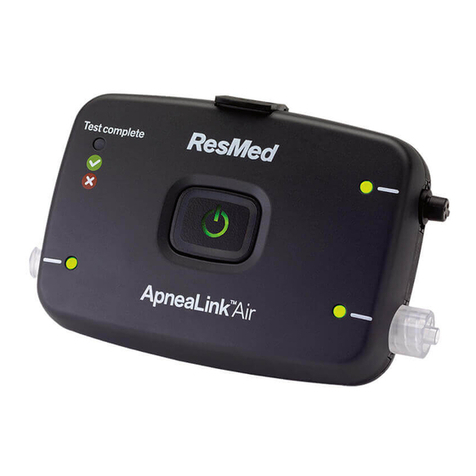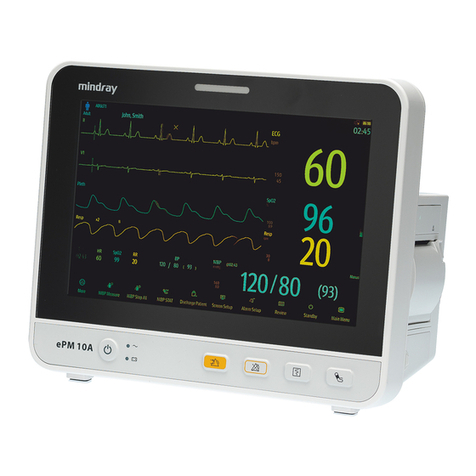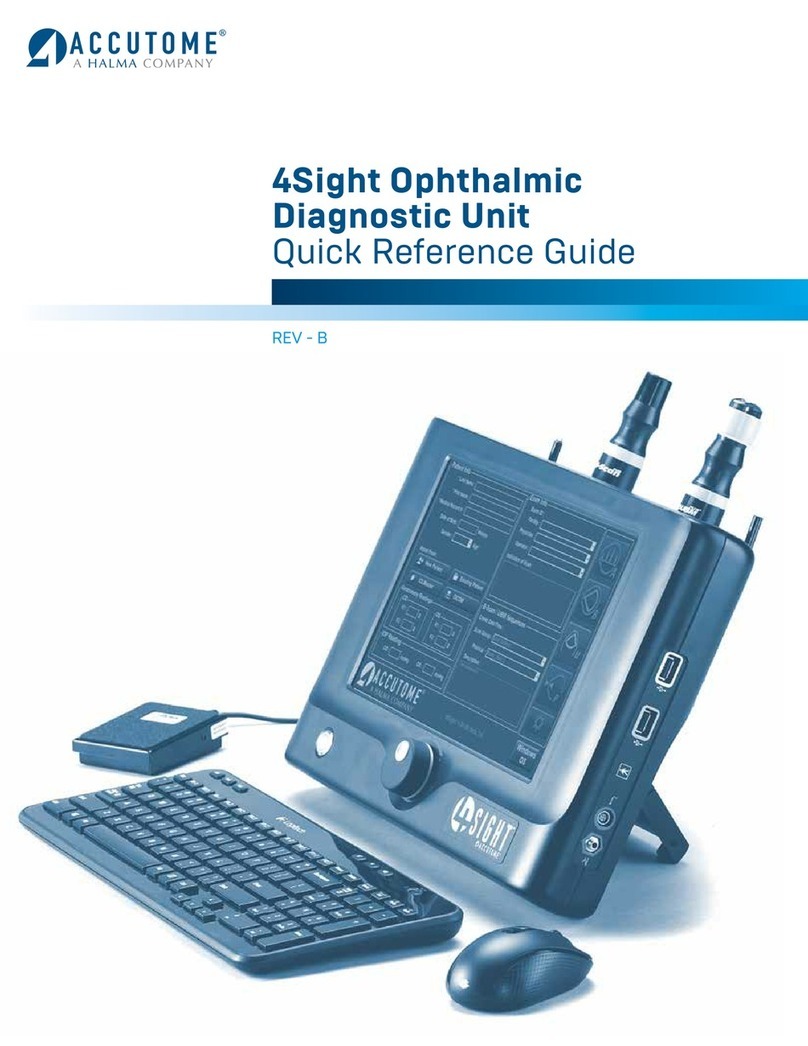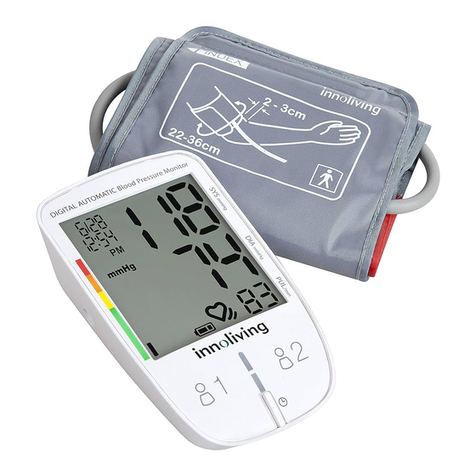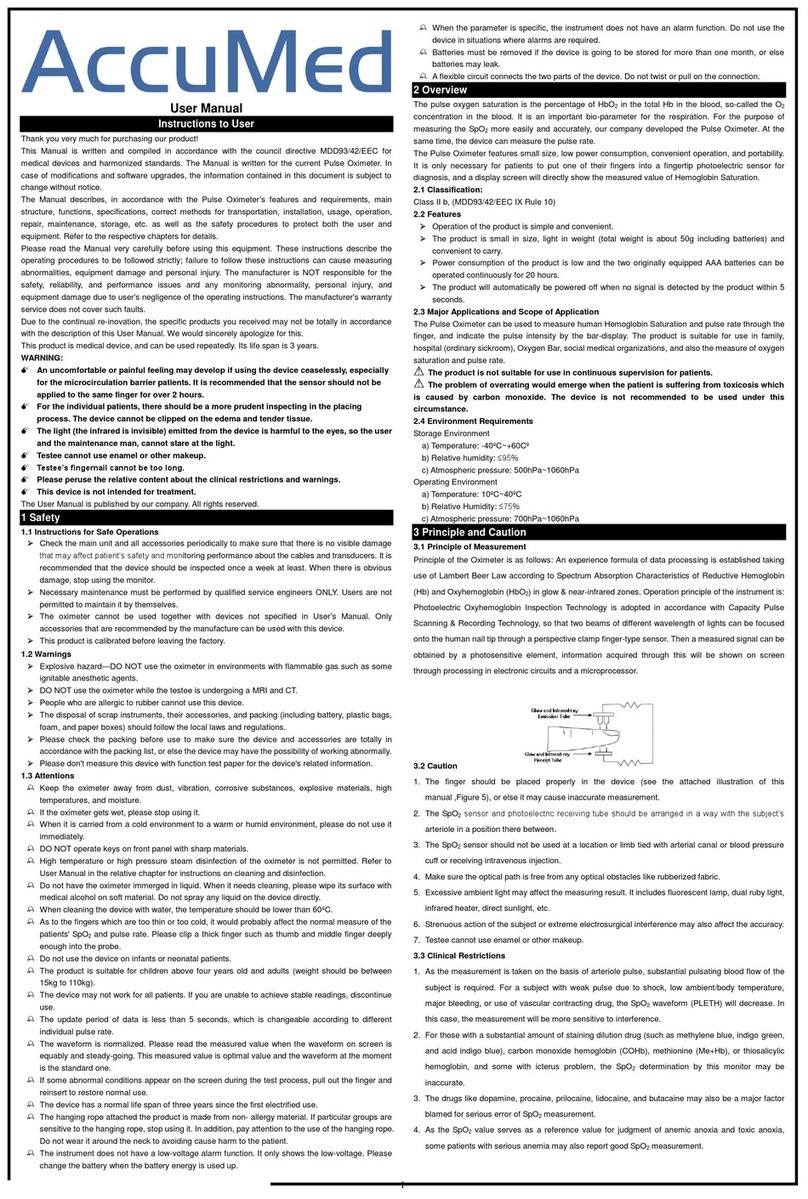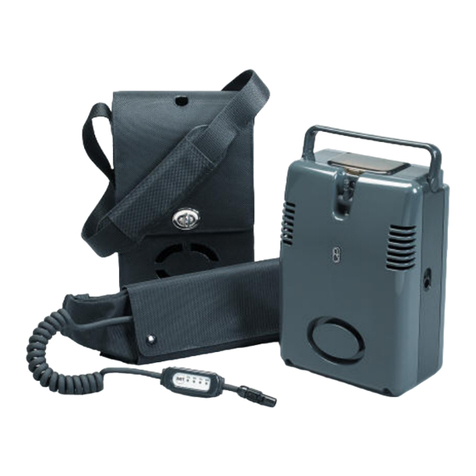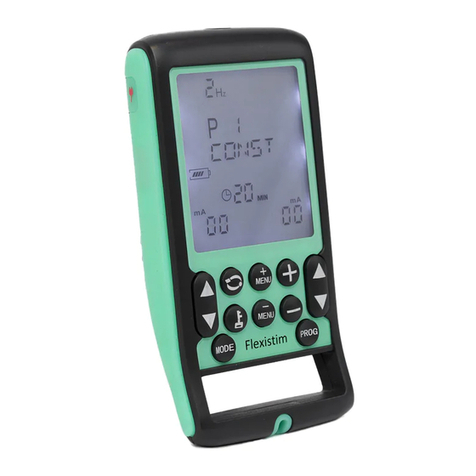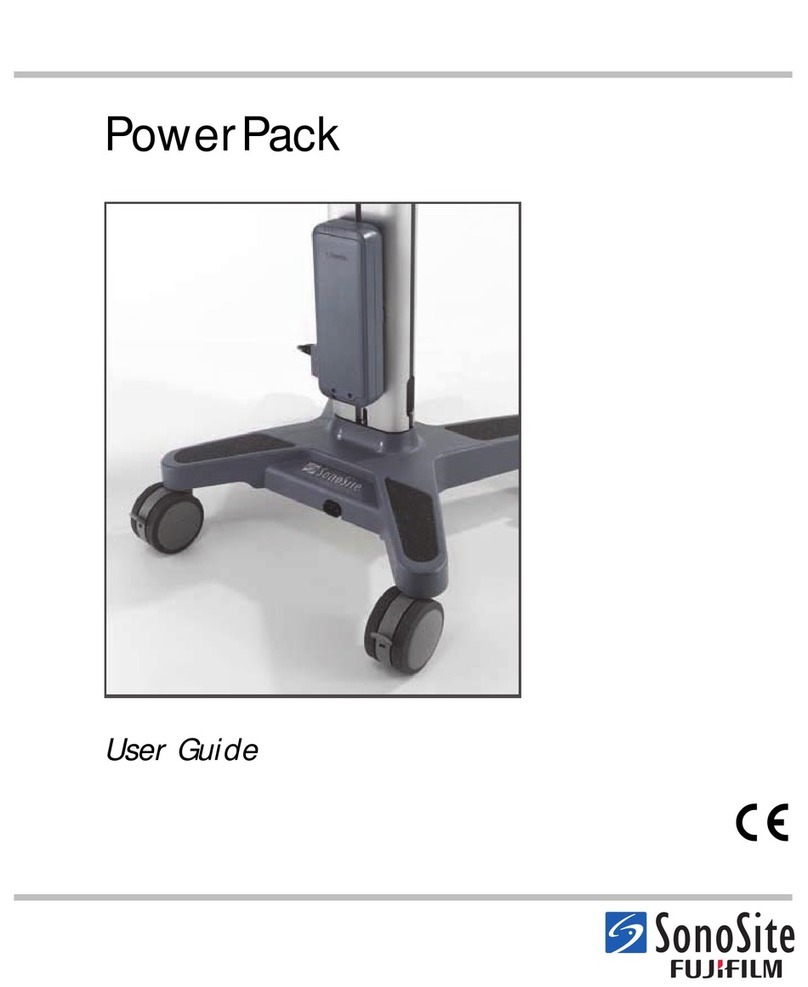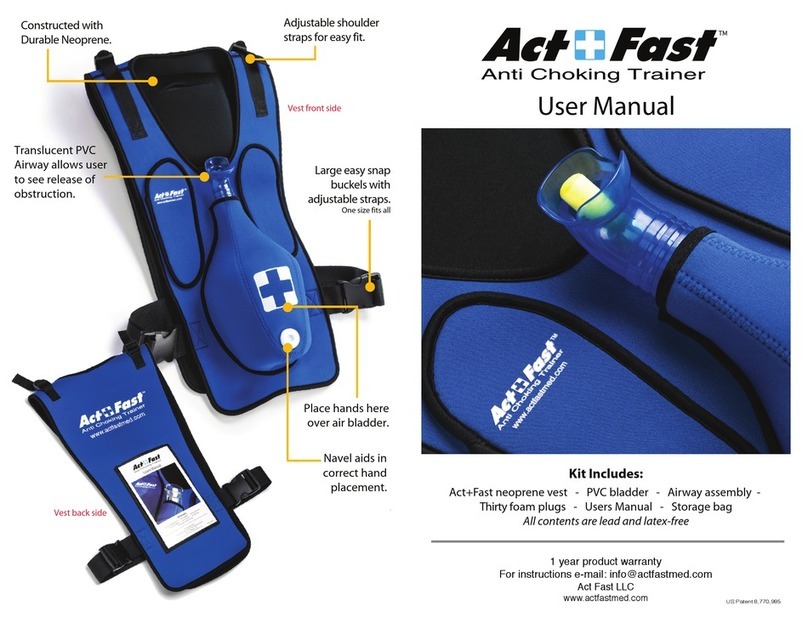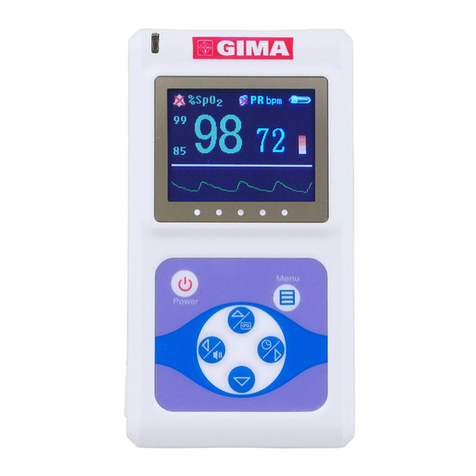Sienco Sonoclot User manual

Sonoclot Analyzer
User Guide
for Cardiopulmonary Bypass Surgery
Rev 1.0
Sienco, Inc.
5721 Arapahoe Ave, Unit A1-A, Boulder, CO 80303 USA
303-420-1148 1-800-432-1624 Fax 303-379-4403

Copyright © 2012-2016 Sienco®, Inc. All Rights Reserved.
Sienco®, Inc.
5721 Arapahoe Ave, Unit A1-A, Boulder CO 80303 USA
1-303-420-1148 1-303-379-4403 (FAX)
[email protected] (e-mail)
http://www.sienco.com
Sonoclot is a registered trademark of Sienco®, Inc.
Sonoclot Analyzers are protected under U.S. and foreign patents.

Table of Contents
Chapter 1: Hemostasis and Why We Care About It in Cardiopulmonary Bypass Surgery 1-1
Overview 1-1
Hemostasis Management Testing Needs 1-1
Hemostasis Management and the Sonoclot Analyzer 1-1
Chapter 2: Hemostasis Fundamentals 2-1
Hemostasis Basics 2-1
Fibrin Gel Formation 2-3
Clot Retraction, i.e. Platelet Function 2-3
Fibrinolysis 2-3
Chapter 3: Evaluating Global Hemostasis with the Sonoclot Analyzer 3-1
The Sonoclot Analyzer Principle of Operation 3-1
Sonoclot Signature 3-1
Sonoclot Analyzer Quantitative Outputs 3-2
Sonoclot Signature Phases 3-2
Chapter 4: Heparin Management in Cardiopulmonary Bypass Surgery 4-1
Heparin 4-1
Heparin Effects on Coagulation 4-1
Heparin Management Objectives 4-2
Activation Reagents for Heparin Monitoring 4-2
Pre Bypass: Baseline 4-4
On Bypass: High Dose Heparin Therapy 4-4
Post Bypass: Heparin Reversal and Hemostasis Restoration 4-4
Platelet Function 4-5
Chapter 5: References and Further Reading 5-1
Chapter 6: Technical Support 6-1
Contact Information 6-1
Exporting Signature Groups from Signature Viewer 6-1


1-1
Chapter 1:
Hemostasis and Why We Care About It in
Cardiopulmonary Bypass Surgery
Overview
Cardiopulmonary bypass surgery degrades hemostasis. There are multiple contributing factors to this
degradation. Heparin is added to inhibit coagulation; blood volume is diluted; coagulation factors and
platelets are activated by bypass circuits and surgical trauma; heparin is reversed with protamine restoring
coagulation; and bleeding depletes clotting factors and platelets.
During bypass, inadequate anticoagulation elevates thrombotic risks. Excessive anticoagulation potentially
impairs hemostasis restoration. Accurate anticoagulation management reduces both thrombotic risk
during bypass and potential bleeding complications after bypass.
Post bypass, hemostasis may be impaired by loss of clotting factors or platelets, residual heparin, or
excessive uncorrected vascular damage. Blood component therapy may be necessary to control bleeding,
but unnecessary use of blood products should be avoided.
Hemostasis performance and clinical management affect patient outcomes and treatment costs. Effective
and comprehensive hemostasis management is one important component of cardiopulmonary bypass
surgery.
Hemostasis Management Testing Needs
Cardiopulmonary bypass surgery teams need to manage heparin administration, neutralize heparin,
and resolve bleeding complications. The specic requirements for hemostasis management throughout
cardiopulmonary bypass surgery may include: pre-surgical screening for potential existing coagulopathies,
verication of adequate anticoagulant therapy prior to bypass, management of anticoagulant therapy
during bypass, and comprehensive hemostasis assessment post bypass and throughout recovery.
Technology trends are moving more advanced instruments into the operating room offering comprehensive
test results of coagulation assessment, platelet function, and overall hemostasis performance with point-
of-care convenience.
Hemostasis Management and the Sonoclot Analyzer
The Sonoclot Analyzer is a sensitive instrument designed to detect and quantify viscoelastic changes in a
whole blood sample that occur throughout hemostasis. Hemostasis testing with the Sonoclot Analyzer has
evolved to address multiple needs of cardiopulmonary bypass surgery including both anticoagulation and
bleeding management. The Sonoclot Analyzer product line is the only integrated solution that addresses
both convenient and cost effective anticoagulation management with global hemostasis monitoring for
managing clinical bleeding.


2-1
Blood has the biomechanical ability to change from a liquid into a brin clot, further evolve into a mature
clot, and nally dissolve back into a liquid. These physiological processes encompass not just coagulation
but also other aspects of overall hemostasis including platelet activation, clot retraction, and lysis. Any
weak link in this coagulation and hemostasis sequential process can result in bleeding complications or
elevated risk of thrombosis.
Hemostasis Basics
The coagulation process addresses the reactions occurring in blood or plasma that precede and initiate
the formation of of brin clot.
The Coagulation Cascade
Traditionally, this process has been explained with a cascade hypothesis. Over years of research
this coagulation hypothesis has been revised and expanded, however it still provides a foundation
for most coagulation testing, including prothrombin time (PT), activated partial thromboplastin time
(aPTT), thrombin time (TT), and activated clotting time (ACT).
The coagulation cascade hypothesis denes three pathways leading to initial brin formation: the
intrinsic, extrinsic, and common pathways. The intrinsic and extrinsic pathways merge into the
common pathway when factor X becomes activated Xa.
Chapter 2:
Hemostasis Fundamentals
XIIa
XIa
Contact Activator
XII
Intrinsic Pathway
IXa
VIII
X
IX
XI
Tissue Factor
Extrinsic Pathway
VII
X
Common Pathway
Xa
V
Prothrombin
Thrombin
Fibrinogen
Fibrin

2-2 Chapter 2: Hemostasis Fundamentals
The Cell Based Model of Coagulation
A newer understanding of the coagulation process, the cell based model, describes three overlapping
phases of coagulation: initiation, amplication, and propagation. A coagulation activator (such as
tissue factor) initiates a sequence of reactions that result in a small amount of thrombin generation. This
sequence of reactions is referred to as the initiation phase. The initial thrombin activates factors VIII
and V, thrombin formation accelerators, which accelerate the activation of factor Xa and subsequent
thrombin during the amplication phase. With these additional activation pathways complete,
thrombin formation continues in the propagation phase of the model. Fibrin formation occurs when
thrombin is present. The rate of brin formation is initially zero until the beginning of the amplication
phase. The rate of brin formation increases during the amplication phase. During propagation,
thrombin formation sustains brin formation until the available brinogen is converted into brin.
Initiation Amplication Propagation
Initial Thrombin Generation
(Initial Clot Formation: Sonoclot ACT)
Initial Thrombin Generation
Thrombin Formation Accelerators
Thrombin Formation Accelerators
Mass Thrombin Generation
(Sustained Rate of Fibrin Formation:
Sonoclot ClotRate)
Activator
Fibrin
Key:
= slow
= fast
= initial reaction
= amplied reaction
Fibrinogen
Activator
XII
XI XIa
XIIa
XXa
Prothrombin (II) Thrombin (IIa)
Activator
XII
XI XIa
XIIa
XXa VVa
Prothrombin (II) Thrombin (IIa)
Fibrinogen Fibrin
VIII VIIIa

Chapter 2: Hemostasis Fundamentals 2-3
Fibrin Gel Formation
Fibrin formation begins with brinogen converting into brin monomers. The brin monomers
spontaneously polymerize into a brin gel. Gel formation is affected by the rate of thrombin formation,
the rate of thrombin neutralization, and the amount of brinogen.
Clot Retraction, i.e. Platelet Function
Clot retraction occurs when platelets function properly. The photograph below shows the roll of platelets
in retracting a clot. The dark lines are strands of brin These brin strands link together into a gel. The
platelets adhere to multiple nodes of the brin gel and cause the gel to collapse together or retract.
Fibrinolysis
Eventually, brin clots dissolve through the activation of the brinolytic system. The activated enzyme
plasmin is formed from plasminogen and breaks brin strands into smaller brin split products. The brin
split products do not polymerize so as this lysing progresses, the brin gel dissolves.
With normal hemostasis, the process of brinolysis occurs at much slower rates than coagulation, brin
gel formation, or clot retraction. Hyperbrinolysis occurs when the clot begins to dissolve before it has
been fully formed, often returning back into a liquid.


3-1
Chapter 3:
Evaluating Global Hemostasis
with the Sonoclot Analyzer
The Sonoclot Analyzer is an advanced global hemostasis analyzer. As a point-of-care device, it is used in
operating rooms and cardiovascular intensive care units to assess hemostasis performance before, during,
and after cardiopulmonary bypass surgery. The Sonoclot Analyzer provides accurate information on the
entire hemostasis process including coagulation, brin formation, clot retraction, and hyperbrinolysis
(when present).
The Sonoclot Analyzer Principle of Operation
The principle of operation within the Sonoclot Analyzer is a microviscometer. The instrumentation is
sensitive to any resistance to motion that the oscillating probe encounters as it moves within the test
sample. The greater the viscosity of the uid, the greater the output signal generated by the analyzer. The
output signal is calibrated to reference viscosity standards and reported in normalized ‘Clot Signal’ units.
Sonoclot Signature
The viscoelastic measurement changes over time
as the clot forms and evolves. The series of Clot
Signal measurements throughout the test analysis
is referred to as the Sonoclot Signature. A typical
Sonoclot Signature is shown to the right. A
Sonoclot Signature is generated for each test and
can be displayed on a personal computer running
Signature Viewer, a data collection, storage, and
retrieval software program customized for the
Sonoclot Analyzer.
Electromechanical
Transducer
Cuvette
Direction of Probe Movement
Tubular Probe
Electronic Circuitry
Reference Signature
Minutes
0.0 5.0 10.0 15.0 20.0 25.0 30.0
Clot
Signal
0
25
50
75
100
125
Group Description
Style Time Test Application Result Range Comment

3-2 Chapter 3: Evaluating Global Hemostasis with the Sonoclot Analyzer
Sonoclot Analyzer Quantitative Outputs
The shape of the Sonoclot Signature tracks the hemostasis process. Quantitative results are extracted from
the Signature to characterize specic aspects of hemostasis performance. These results are: ACT, Clot Rate,
and Platelet Function results. Results are displayed on the instrument’s LCD module. An understanding
of the relationship between these results and the Sonoclot Signature is useful in understanding both the
meaning of the results and the performance of the associated aspect of hemostasis performance. More
details follow.
Sonoclot Signature Phases
In each test run on the Sonoclot Analyzer, a reagent is added to a whole blood sample that initiates the
clot formation process. The resulting Sonoclot Signature can be divided into separate phases that relate
to specic aspects of hemostasis performance.
Coagulation Reaction Phase
This rst phase is the period from the beginning
of the test when the sample is still a liquid until
the point when brinogen begins to convert
into a brin gel, thus increasing the viscosity of
the sample. The Sonoclot Analyzer produces
an automated result, the Activated Clotting
Time (ACT). This result is the time when the
viscosity measurement rises by 1.0 Clot Signal
units on the Sonoclot Signature.
Clot Formation Phase
This phase is the period when fibrinogen
converts to brin and forms a brin gel. The
Sonoclot Analyzer produces an automated
result, the Clot Rate. The Clot Rate is the
maximum slope of the Sonoclot Signature
during initial gel formation.
Reference Signature
Minutes
0.0 5.0 10.0 15.0 20.0 25.0 30.0
Clot
Signal
0
25
50
75
100
125
Group Description
Style Time Test Application Result Range Comment
Clot Retraction Phase
Platelet Function -
the amount of
change in the
Signature after
clot formation
Reference Signature
Minutes
0.0 5.0 10.0 15.0 20.0 25.0 30.0
Clot
Signal
0
25
50
75
100
125
Group Description
Style Time Test Application Result Range Comment
Reaction Time
Coagulation Reaction Phase

Chapter 3: Evaluating Global Hemostasis with the Sonoclot Analyzer 3-3
Clot Retraction Phase
During this phase, clot retraction causes a
peak or peaks on the Sonoclot Signature. The
Sonoclot Analyzer produces an automated
result called “Platelet Function.” The Platelet
Function number quanties the quality of the
clot retraction process. Results range between
0 (no clot retraction) and approximately 5
(strong clot retraction).
Historically, platelet function was manually
calculated from the Sonoclot Signature.
Different researchers used different techniques
and terms for quantifying clot retraction.
Some of those terms include: Time-to-Peak, R2, Peak Angle, Upslope, or Downslope. While some of
these terms generated useful results, the range of shapes of Sonoclot Signatures resulted in problems
with consistent interpretation between users. The quantitative Platelet Function result provides an
automated and convenient result for characterizing clot retraction within a test sample.
Reference Signature
Minutes
0.0 5.0 10.0 15.0 20.0 25.0 30.0
Clot
Signal
0
25
50
75
100
125
Group Description
Style Time Test Application Result Range Comment
∆Clot Signal
∆minutes
Clot Rate ( )
Clot Formation Phase


4-1
Heparin
Heparin is a naturally occurring polysaccharide. When it binds with antithrombin, a protein within blood,
the heparin antithrombin complex alters many clotting factors and reactions. Unfractionated heparin is
the most commonly used anticoagulant during cardiopulmonary bypass surgery.
Heparin Effects on Coagulation
Heparin affects the clot formation process in multiple ways. Two signicant effects on clot development
are: higher heparin concentrations prolong the Coagulation Reaction Phase, increasing the ACT result,
and prolong the Clot Formation Phase, decreasing the Clot Rate. A heparin dose response on the Sonoclot
Signature is shown here. This heparin dose response, run using kaolin activation with Sienco’s kACT test,
shows the same blood sample run with different heparin concentrations.
The ACT result increases approximately linearly with
increasing heparin concentration. The ACT result generated
with the kACT is intended for high dose heparin management.
Important: ACT results among various instruments or activation
formulations can differ signicantly. When considering an
alternate ACT result for heparin management, a method
comparison between the specic instruments and reagents is
necessary to ensure consistent heparin administration between
devices or reagents.
Chapter 4:
Heparin Management in
Cardiopulmonary Bypass Surgery
0
100
200
300
400
500
600
700
800
0123456
ACT versus Heparin Concentration
ACT (seconds)
Heparin Concentration (IU/mL whole blood)
kACT

4-2 Chapter 4: Heparin Management in Cardiopulmonary Bypass Surgery
The change in Clot Rate is non-linear. Clot Rate decreases
with increasing heparin concentrations. The Clot Rate
is initially very sensitive to changes in heparin and
becomes less sensitive to changes in heparin at higher
heparin concentrations. The ACT and Clot Rate results
together provide a more comprehensive assessment of the
anticoagulant effect of heparin. Recent publications have
shown the Clot Rate to provide higher statistical signicance
to heparin levels than conventional ACT results.
The ACT shows a delay in initial clot formation, but the
real objective of heparin is suppressing clot formation. The
Clot Rate result shows the important anticoagulant effect
of suppressing brin formation and therefore is more specic for monitoring heparin’s ability to suppress
clot formation rather than just delay clot formation. The Sonoclot Analyzer is a superior instrument for
managing heparin because it characterizes both the coagulation reaction time typical of ACT instruments
and additionally characterizes the development of the actual clot.
Heparin Management Objectives
Proper dosing of heparin during treatment improves patient outcomes since under-administration elevates
the risk of forming unwanted blood clots, and over-administration elevates the risk of bleeding. Heparin
is metabolized. In order to maintain desired therapeutic heparin concentrations, heparin must be re-
administrated periodically during cardiovascular bypass surgery. Accurate heparin dosing requires heparin
monitoring to guide heparin re-administration.
Activation Reagents for Heparin Monitoring
Any coagulation test is a combination of many separate processes including collecting a blood sample,
activating the blood sample, and analyzing the blood sample. The specic activator used for a test
inuences the test results and no one activator works well for all applications. In cardiovascular surgery,
there are two primary hemostasis states for the patient: when anticoagulation has been inhibited by high
dose heparin therapy and when coagulation should be functioning normally. Hemostasis management
can be much more specic if appropriate reagents are selected for these two hemostasis states.
For high dose heparin therapy, standard ACT activators including celite or kaolin, are typically used to
direct heparin therapy management. While these same activators are often used for baseline and post
protamine assessment of coagulation, testing samples with little or no heparin can be signicantly improved
by using a reagent optimized for samples that do not contain high levels of heparin. Sienco recommends
two different activators for cardiovascular surgery: kaolin for high dose heparin therapy management, and
glass beads for baseline, post protamine, and ICU testing. Understanding the difference in performance
of these two activators is important.
0
5
10
15
20
25
30
35
0123456
Clot Rate versus Heparin Concentration
Clot Rate (∆Clot Signal/∆minutes)
Heparin Concentration (IU/mL whole blood)
kACT

Chapter 4: Heparin Management in Cardiopulmonary Bypass Surgery 4-3
Here are heparin dose response Signatures run using kaolin (kACT) and glass beads (gbACT+).
Below are heparin dose response graphs for both ACT and Clot Rate results for these Signatures.
Both ACT results show a linear relationship between the ACT result and the heparin concentration. The
kACT covers a heparin concentration range typical for high dosage heparin therapy while the gbACT+
covers a much smaller heparin range that only extends to about 1 IU/mL. The kACT results are appropriate
for managing high dose heparin therapy but are insensitive to small amounts of heparin. The kACT is a
poor test for detecting residual heparin. The gbACT+ test will be signicantly prolonged for even small
amounts of residual heparin making it a preferred formulation for detecting residual heparin.
IMPORTANT: Do not use the gbACT+ test for high dosage heparin therapy.
Heparin-kACT
Minutes
0.0 5.0 10.0 15.0 20.0
Clot
Signal
0
25
50
75
100
125
Linearity Study
BB Citrated
6/9/2010
kACT
Group Description
Style Time Test Application Result Range Comment
0 1 2345
Heparin (IU/mL whole blood)
Heparin Dose Response
using kACT
Heparin-gbACT+
Minutes
0.0 5.0 10.0 15.0 20.0 25.0 30.0
Clot
Signal
0
25
50
75
100
125 Group Description
Style Time Test Application Result Range Comment
0.0
0.2 0.3
0.4 0.5
0.6
0.8
0.1
Heparin (IU/mL whole blood)
Heparin Dose Response
using gbACT+
Heparin-kACT
Minutes
0.0 5.0 10.0 15.0 20.0
Clot
Signal
0
25
50
75
100
125
Linearity Study
BB Citrated
6/9/2010
kACT
Group Description
Style Time Test Application Result Range Comment
0 1 2345
Heparin (IU/mL whole blood)
Heparin Dose Response
using kACT
Heparin-gbACT+
Minutes
0.0 5.0 10.0 15.0 20.0 25.0 30.0
Clot
Signal
0
25
50
75
100
125
Group Description
Style Time Test Application Result Range Comment
0.0
0.2 0.3
0.4 0.5
0.6
0.8
0.1
Heparin (IU/mL whole blood)
Heparin Dose Response
using gbACT+
Heparin-kACT
Minutes
0.0 5.0 10.0 15.0 20.0
Clot
Signal
0
25
50
75
100
125
Linearity Study
BB Citrated
6/9/2010
kACT
Group Description
Style Time Test Application Result Range Comment
Sonoclot Signature versus
Heparin Concentration
0
5
10
15
20
25
30
35
012345
Clot Rate versus Heparin Concentration
Clot Rate (∆Clot Signal/∆minutes)
Heparin Concentration (IU/mL whole blood)
0
5
10
15
20
25
0 0.2 0.4 0.6 0.8
Clot Rate versus Heparin Concentration
Clot Rate (∆Clot Signal/∆minutes)
Heparin Concentration (IU/mL whole blood)
gbACT+
0
5
10
15
20
25
30
35
0123456
Clot Rate versus Heparin Concentration
Clot Rate (∆Clot Signal/∆minutes)
Heparin Concentration (IU/mL whole blood)
kACT
kACT
gbACT+
100
200
300
400
500
600
700
800
012345
ACT versus Heparin Concentration
ACT (seconds)
Heparin Concentration (IU/mL whole blood)
kACT
gbACT+
0
100
200
300
400
500
600
0 0.2 0.4 0.6 0.8
ACT versus Heparin Concentration
ACT (seconds)
Heparin Concentration (IU/mL whole blood)
Heparin-gbACT+
Minutes
0.0 5.0 10.0 15.0 20.0 25.0 30.0
Clot
Signal
0
25
50
75
100
125 Group Description
Style Time Test Application Result Range Comment
0
100
200
300
400
500
600
700
800
0123456
ACT versus Heparin Concentration
ACT (seconds)
Heparin Concentration (IU/mL whole blood)
kACT
gbACT+
Heparin-kACT
Minutes
0.0 5.0 10.0 15.0 20.0
Clot
Signal
0
25
50
75
100
125
Linearity Study
BB Citrated
6/9/2010
kACT
Group Description
Style Time Test Application Result Range Comment
Sonoclot Signature versus
Heparin Concentration
0
5
10
15
20
25
30
35
012345
Clot Rate versus Heparin Concentration
Clot Rate (∆Clot Signal/∆minutes)
Heparin Concentration (IU/mL whole blood)
0
5
10
15
20
25
0 0.2 0.4 0.6 0.8
Clot Rate versus Heparin Concentration
Clot Rate (∆Clot Signal/∆minutes)
Heparin Concentration (IU/mL whole blood)
gbACT+
0
5
10
15
20
25
30
35
0123456
Clot Rate versus Heparin Concentration
Clot Rate (∆Clot Signal/∆minutes)
Heparin Concentration (IU/mL whole blood)
kACT
kACT
gbACT+
100
200
300
400
500
600
700
800
012345
ACT versus Heparin Concentration
ACT (seconds)
Heparin Concentration (IU/mL whole blood)
kACT
gbACT+
0
100
200
300
400
500
600
0 0.2 0.4 0.6 0.8
ACT versus Heparin Concentration
ACT (seconds)
Heparin Concentration (IU/mL whole blood)
Heparin-gbACT+
Minutes
0.0 5.0 10.0 15.0 20.0 25.0 30.0
Clot
Signal
0
25
50
75
100
125 Group Description
Style Time Test Application Result Range Comment
0
100
200
300
400
500
600
700
800
0123456
ACT versus Heparin Concentration
ACT (seconds)
Heparin Concentration (IU/mL whole blood)
kACT
gbACT+

4-4 Chapter 4: Heparin Management in Cardiopulmonary Bypass Surgery
Pre Bypass: Baseline
Running a sample prior to heparin is useful to gain an
understanding of the patient’s hemostasis performance.
The recommended test is a glass bead activated
differential heparinase panel. One channel runs a
glass bead activated test which is Sienco’s preferred
reagent for comprehensive hemostasis evaluation;
the other channel runs a heparin neutralized glass
bead activated test. The reason for running a heparin
neutralized test is to ensure that the baseline test has
not been compromised by some unexpected heparin
contamination or pre-administration. The Sonoclot
Signatures above show a baseline with a small amount
of unexpected heparin.
On Bypass: High Dose Heparin Therapy
High dose heparin management using the Sonoclot Analyzer’s ACT result is similar to using other ACT
instruments. The Sonoclot Analyzer also offers the added benet of the Clot Rate result that quanties
how fast the clot develops after the ACT result has been calculated. The objective of anticoagulant
management is to prevent clot formation. The Clot Rate result is a more direct measurement of heparin’s
effect of clot formation. Multiple researchers have found the Clot Rate result to be more specic to
heparin concentration than the ACT.
One recommended approach for comprehensive heparin management is to establish both ACT and
Clot Rate thresholds. Additional heparin is administered when either the ACT is below an established
threshold or the Clot Rate is above an established threshold. Typically, Clot Rate results are below 6
during high dose heparin therapy.
Post Bypass: Heparin Reversal and Hemostasis Restoration
There are two coagulation concerns after bypass: adequate heparin reversal and overall hemostasis
performance.
Since both residual heparin and coagulation factor deciencies may be detected after protamine
administration, running two tests, one with and one without heparin neutralization, provides comprehensive
and specic results to characterize overall hemostasis performance.
In this post protamine example, the gbACT+ test showed
a prolonged ACT and reduced Clot Rate. These results
could indicate either residual heparin or inadequate
coagulation factors. The heparin neutralized version
of the gbACT+ test showed normal results for the
ACT and Clot Rate. The heparin neutralized test also
showed normal clot retraction. The amount of residual
heparin in this example can easily be missed with a
standard ACT.
Patient 2 Pre
Minutes
0.0 5.0 10.0 15.0 20.0 25.0 30.0
Clot
Signal
0
25
50
75
100
125
Group Description
Style Time Patient Test Application Operator Result Range
Heparin Neutralized
Control
glass bead activated tests
Patient 2 Post
Minutes
0.0 5.0 10.0 15.0 20.0 25.0 30.0
Clot
Signal
0
25
50
75
100
125
Group Description
Style Time Test Application Result Range Comment
Control
Heparin Neutralized
glass bead activated tests

Chapter 4: Heparin Management in Cardiopulmonary Bypass Surgery 4-5
It is important to note that protamine itself can have an anticoagulant effect if too much protamine has
been administered or if the blood sample is tested before enough time has passed for the protamine to
fully neutralize the heparin.
Platelet Function
The Sonoclot Signature Clot Retraction Phase is the period when clot retraction is occurring within the
test sample. This phase is inuenced by activated platelets retracting the clot. This point can be illustrated
by looking at Sonoclot Signatures that have platelets inhibited by anti-platelet drugs.
The result of reducing platelet function by inhibiting platelets attenuates and nally eliminates clot
retraction. The Sonoclot Signatures get atter and atter after the brin clot forms. Note that the effect
of inhibiting platelets does not affect either the Coagulation Reaction Phase (ACT) or the Clot Formation
Phase (Clot Rate). The Platelet Function result is specic to clot retraction and brin clots can form without
any clot retraction. Low platelet function results provide a useful indicator to help guide platelet blood
component therapy. Important: useful platelet function results require that a brin clot forms. Heparin,
inadequate coagulation factors, or low brinogen can all contribute to impaired clot retraction. In order
to properly identify poor platelet function, rst ensure that the Sonoclot Signature or ACT and Clot Rate
results are sufcient to form a brin clot. If either the ACT or Clot Rate results indicate an inability to
form a brin clot, this coagulopathy needs to be corrected prior to using the Platelet Function result as
an indicator of poor platelet function.
Integrilin
Minutes
0.0 5.0 10.0 15.0 20.0 25.0 30.0
Clot
Signal
0
25
50
75
100
125
Group Description
Style Time Test Application Result Range Comment
1
23
4
5
Increasing Reagent: 1 to 5
Integrilin 2
Minutes
0.0 5.0 10.0 15.0 20.0 25.0 30.0
Clot
Signal
0
25
50
75
100
125 Group Description
Style Time Test Application Result Range Comment
1
23
45
Increasing Reagent: 1 to 5
Integrilin
Integrilin
Aggrastat
Minutes
0.0 5.0 10.0 15.0 20.0 25.0 30.0
Clot
Signal
0
25
50
75
100
125
Group Description
Style Time Test Application Result Range Comment
Aggrastat
Increasing Reagent: 0, 1, ...
0
12
3
4

Table of contents
Popular Medical Equipment manuals by other brands
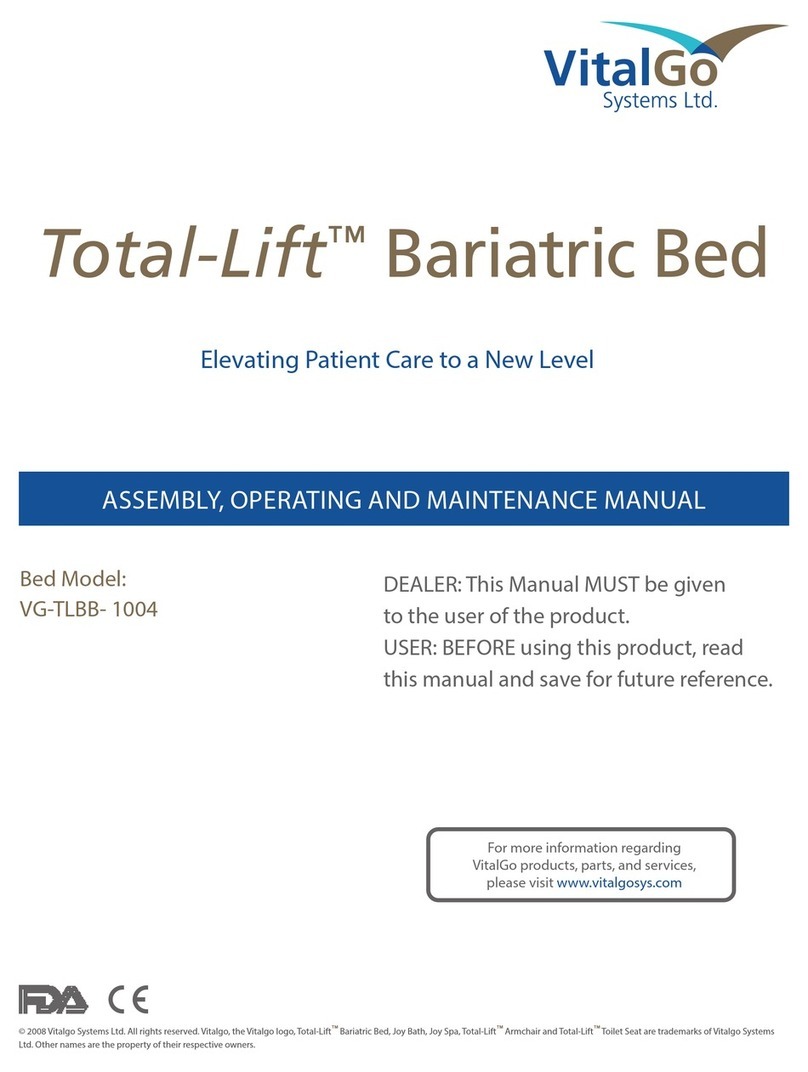
VitalGo
VitalGo Total-Lift VG-TLBB- 1004 Operating and maintenance manual

Summit Medical
Summit Medical EarPopper EP-2100A Instructions for use
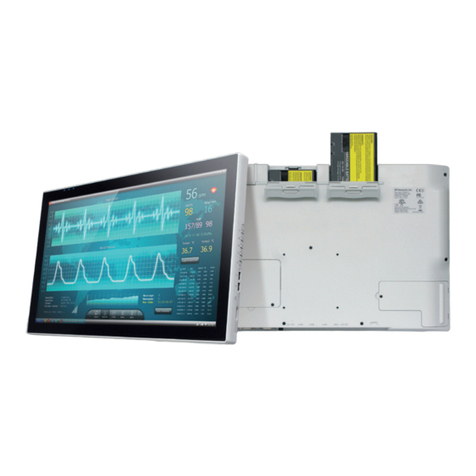
DT Research
DT Research DT592SC Basic operation guide
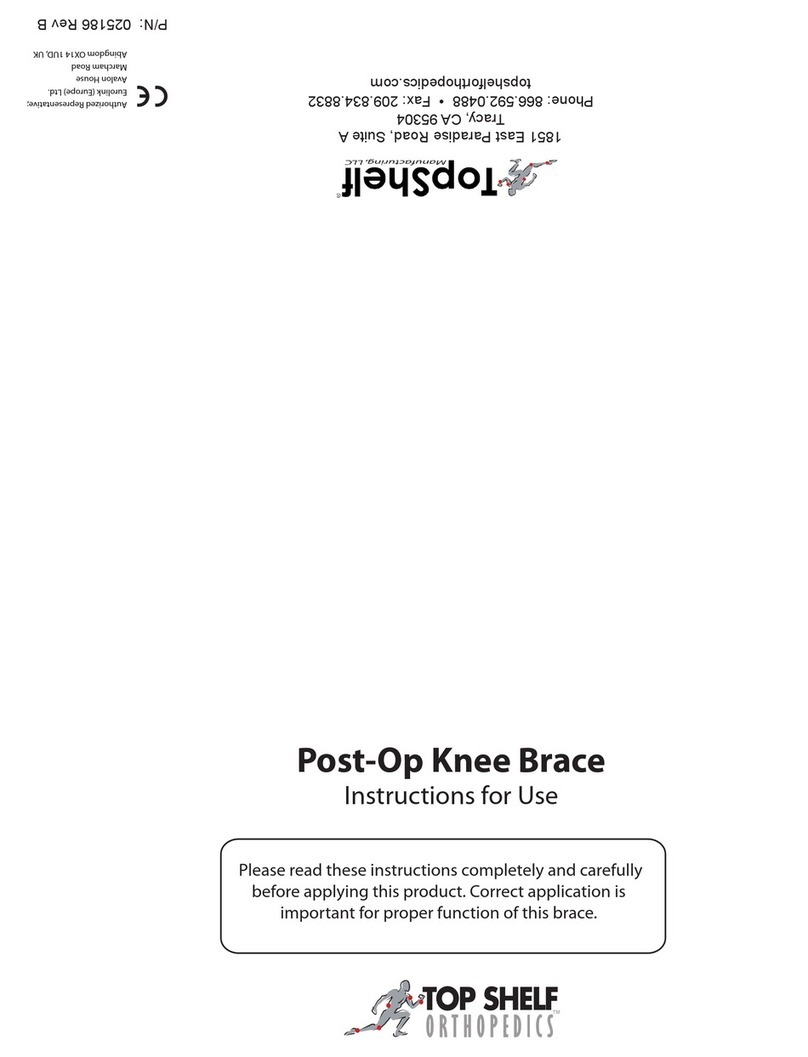
Top shelf Orthopedics
Top shelf Orthopedics Post-Op knee brace Instructions for use

3M
3M Litmann Quality 3100 quick start guide

Creative
Creative PC-60NW-1 user manual
